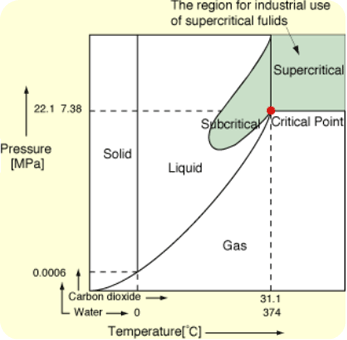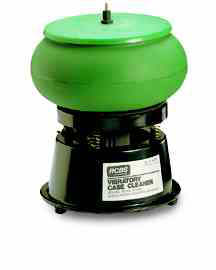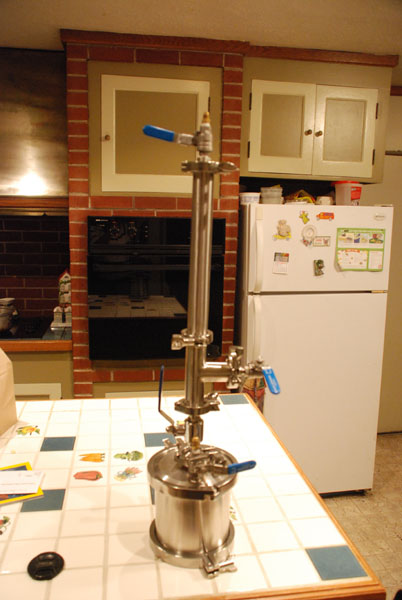Greetings Skunk Pharmers, friends and readers. In my first SPR article I introduced you to someone I met early in my cannabis career whose evolution I’ve been intrigued by. I’m hopeful that my profile on Old West Hemp founder Chris Gromek gave folks some insight into an entrepreneur’s evolution from cannabis marketer to dirt farmer.
A Chance Meeting?
Today I’m excited to share my insights from working with my favorite engineer, Tom Sage from Sage Machine Design. A few years ago one of my extraction lab clients needed to reclaim large volumes of solvent (ethanol) used for cannabis extraction. Traditional rotary evaporators lacked sufficient capacity and throughput for their application so we went looking for something bigger and more efficient.
Someone along the way suggested that the client consider a falling film evaporator which is similar to an alcohol still in some regards. A friend of mine with an affinity for cannabis extraction science was working building custom stainless steel brewing systems. The idea sparked in my mind to introduce the cannabis extractor and the fabricator.
I brought the extraction client to my friend’s at Agile Stainless to see if there was synergy between the groups, and there was. Not long after that introduction I met an engineer working with Agile, Tom Sage, who was consulting on the project. Keeping a long story short, they all dove together into the wonderland of cannabis chemistry. The project resulted in a pair of what today is considered a mid-scale falling film reclamation skid capable of over 20 litres per hour of solvent reclamation.
Meeting Tom at Agile was a “happy accident” that turned into something evolutionary for us both. We’ve worked on a couple fun projects since including one that cemented our desire to collaborate: mechanically capping acrylic vape cartridges filled with distilled cannabis oil.
Crunching Cartridges
After the successful falling film project I brought another client to Agile who needed a reliable vape cartridge mouthpiece press. The client was filling Delrin bricks holding 113 acrylic cartridges with THC distillate, then using a MacGyver style 1-ton hydraulic press modified to seat the mouthpieces onto the cartridges. Unfortunately, the press was imprecise and would sometimes flatten an entire tray of cartridges worth over $1,000. Losing that much money a couple times a week was sufficient incentive for the client to invest in an improved press.
Agile fabricated some parts for the original press but they also suggested that Tom could design a precision cartridge mouthpiece press that would both increase throughput and reduce product waste. The client was filling 2,000-3,000 cartridges per day but wanted to triple that amount. The cart press development process took over a year but the end result was a 20-ton air-driven hydraulic cartridge press design that safely and accurately seated 12,000 vape cartridge mouthpieces per 10-hour shift without smashing any carts.
Something Tom learned in the process is that a one-man operation can struggle to design, build, install, manufacture and support a fleet of machines in the field. So in the end Tom sold the rights for the design to a company which today sells presses based on our original design. Sometimes being successful in business isn’t necessarily about how much money you can make today but more importantly knowing if what you’re doing is sustainable.
Don’t Pay Extra
Vendors and consultants in the cannabis industry often charge a premium for their services. I call it the “weed tax.” Most licensed cannabis business owners have either been quoted or paid inflated prices on a project simply because their work involves marijuana. Some vendors perceive working with this industry as high risk, while others have the misconception that cannabis business owners have money to burn. This “tax” can result in an inflated budget that can either delay a project or make it unfeasible.
The latest client referral I sent Tom is an extractor who needed an efficient, affordable ethanol chilling and transfer solution. The client’s extraction solvent is ethanol instead of the more traditional CO2 or Hydrocarbons like butane or propane. Ethanol used for primary extraction is typically chilled to around -35 degrees Centigrade to be most effective at separating cannabinoids from dry plant material while excluding undesirable plant components from the tincture or micelle. After reclaiming the ethanol solvent it is then filtered and chilled for re-use which although it may sound simple but must be done properly to be both efficient and safe.
The original vendor quote the extraction lab owner received for the ethanol cooling and transfer system was close to $50,000 not including the chiller. Tom analysed the lab’s system parameters then used off-the-shelf parts and an elegant design to create something comparable to the first vendor for less than one third of the cost. That’s over $30,000 savings on a single piece of equipment that the lab owner kept in their pocket to invest elsewhere.
I’m sure that more good ideas are popping off in Tom’s head right now for using innovative designs to help our industry partners improve safety, increase efficiency and grow profits. So I decided to ask Tom a few questions about his work that will hopefully spark a good idea in your head and get dreaming up something new for your cannabis business...
- Q - Good evening Tom! How would you introduce yourself to our readers?
- A - Well, I try to be pretty low key. Usually I listen a lot. Until I know what’s really going on.
- Q - What was your daily grind before starting Sage Machine Design?
- A - I was stuck designing electronics enclosures for a machine I knew could be made a lot better.
- Q - Did engineering come naturally to you or was there something else that came before that? Did you have to overcome significant challenges along the way?
- A - When I was a kid I was more of an artist, and would get in trouble for building things instead of doing my homework. So I didn’t realize until I was in my 20s that engineering was a thing people valued.
- Q - What was your first engineering project after leaving school?
- A - I sat at a microscope and built Superconducting Quantum Interference Devices. Yeah, nobody knows what those are, but they are amazing!
- Q - Is there a specific project that convinced you that engineering was your thing?
- A - I was rebuilding an engine on the rug in my apartment and I became overwhelmed by how perfect all the parts were. They were like ideas made solid that could actually do something valuable.
- Q - Can you suggest any helpful engineering resources you’ve used to advance your work and knowledge, or something in general you’d recommend people check out?
- A - EngineersEdge.com And keep a Mcmaster Carr catalog on the bedside table.
- Q - What keeps your creative mind occupied when you’re not busy with work?
- A - I do a lot of artwork, run, and play piano. Eventually, those things will fill all my time.
- Q - Is there something about your skills and work that you think differentiates you from other engineering consultants?
- A - Yes. I studied physics, because I could not decide on a particular engineering field. But all the specialties of engineering share similar math and physical principles. Of course, I had to study mechanics and electronics and other areas on my own in order to do work in the real world. The approach to problem solving in physics is to find the simplest solution first. They talk about starting out by assuming the cow is spherical, for instance. Often an engineering issue is all tied up with related details that really don’t matter. There is usually one crucial issue to focus on and the rest either falls into place or falls away.
- Q - You’ve designed and built a lot of cool gadgets and worked on diverse projects. Do you have a favorite you can tell our readers about and why you enjoyed working on it?
- A - Right at the time the government defunded fetal stem cell research, I designed a machine that would extract stem cells from adipose tissue. I recall thinking, “F--- you politicians, science will find a way around you!”
- Q - Can you call out a job that especially challenged you or was beyond your capabilities, and how you handled communicating that to your client?
- A - I kind of thrive at the limit of my capabilities. That is where the fun is. I usually make it clear up front when I’m trying something I’ve never done.
- Q - How were you introduced to the cannabis industry?
- A - Before it was legal in California, I was asked to help out with the design of a processing plant. I knew nothing about cannabis. It was located in the hills of Malibu behind big walls. Very secretive. I just remember seeing two 20 foot diameter tanks labeled “water” and being told they were filled with butane! I do not know if that place survived this year’s brush fires, but I assume we would have heard the explosion.
- Q - You and I have talked about the “weed tax” that many service providers and equipment vendors charge customers simply because they’re in the marijuana industry. Is there a piece of advice you’d share with SPR readers that could help them avoid paying extra because they work with marijuana?
- A - Look to other industries for equipment that does the same thing. Falling film is used in producing orange juice, for example. Extraction equipment has been used for ever in all sorts of other food and chemical industries. The cold temperatures and the explosive nature of the solvents don’t make it that special.
- Q - Is the work you do designing tools and systems for the cannabis industry markedly different from your work in the brewery and fermenting industry?
- A - There are a lot of similarities. It’s a lot of heat transfer, mixing and pumping. But brewing conferences are a blast! Brewers are the nicest, most collaborative folks of any industry I’ve worked in.
- Q - Are there any particular engineering market segments that you try to avoid working in or jobs you avoid, and why?
- A - I can’t work for large companies. I just don’t fit in.
- Q - Have you made any major expenditures or purchases (advertising, equipment, etc.) that you’d advise someone starting a consulting company to avoid?
- A - Don’t spend a lot on individual software seats. The new model is to pay a small amount for web based software.
- Q - Where do you see yourself in a year, 5 years, etc.
- A - In 5 years? Playing in a jazz band in a small town in the mountains.
- Q - Is there a person or company you think would be exciting to work with? Maybe a new product or industry you’re curious about?
- A - I would love to help design an airplane.
- Q - Is there something about the industries your work with that you’d change if you could?
- A - Architecture: The elaborate team structure they use makes it almost impossible to solve small problems quickly. Nobody fully owns the results. They really need to figure out a better way.
- Q - If the cannabis extraction and brewing industries suddenly disappeared, something like a prohibition apocalypse, what do you imagine you’d do for work?
- A - Toys
- Q - Is there anything you’d do differently along the way considering your current knowledge and experiences?
- A - I would have loved to start engineering earlier than I did. There’s not going to be enough time to do everything.
Company Background
Engineering services to small manufacturing companies.
Location: Portland, OR.
Founded: 1990
Founder: Tom Sage
Contact: tsage@sagemachines.com 503-833-2745
Company structure: LLC
Thanks to Tom for taking the time to share his thoughts, insights and experiences with all us Skunk Pharmers. SPR readers should keep an eye out for an upcoming SPR Profile Article on best practices and practices for making Ice Water Bubble Hash. Stay tuned!





